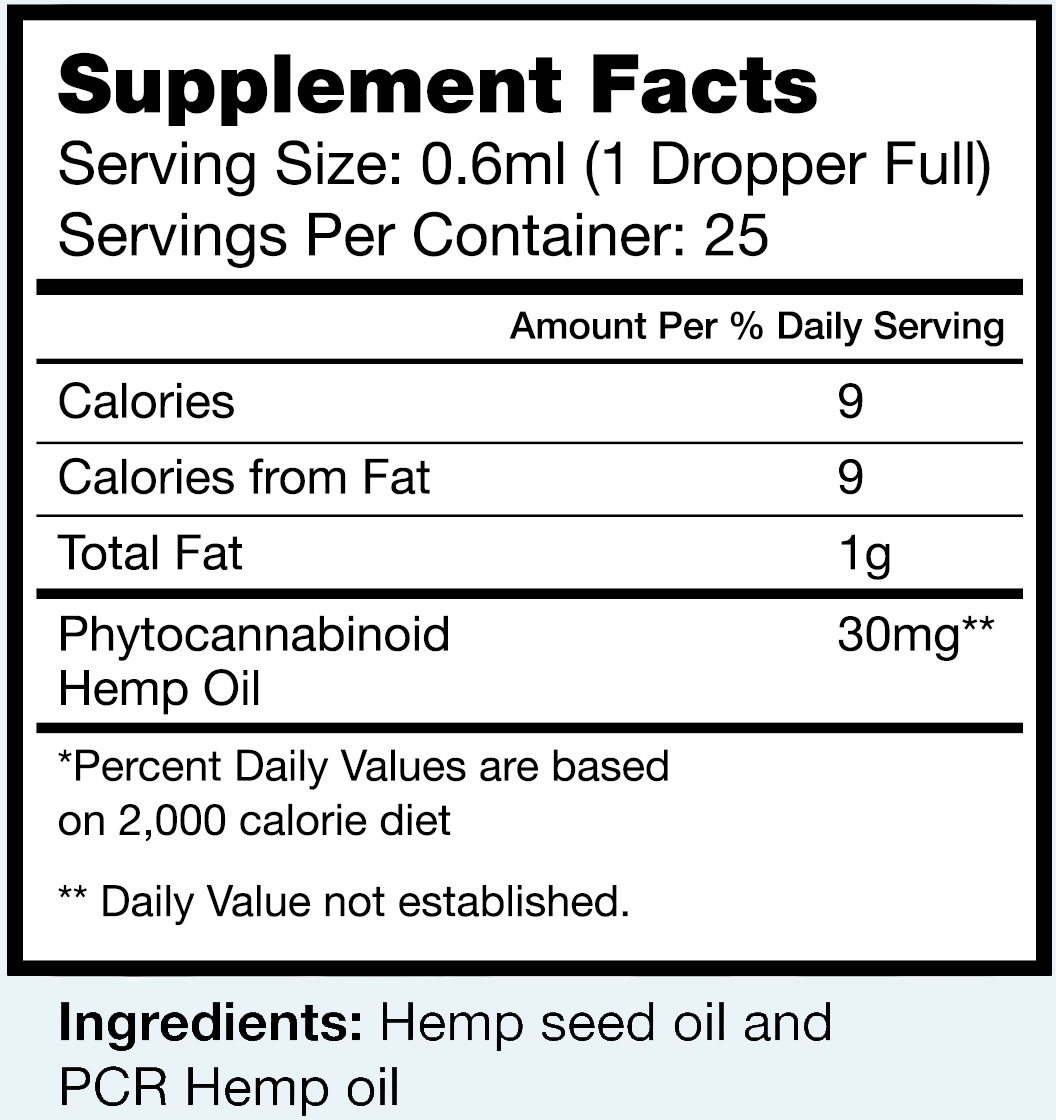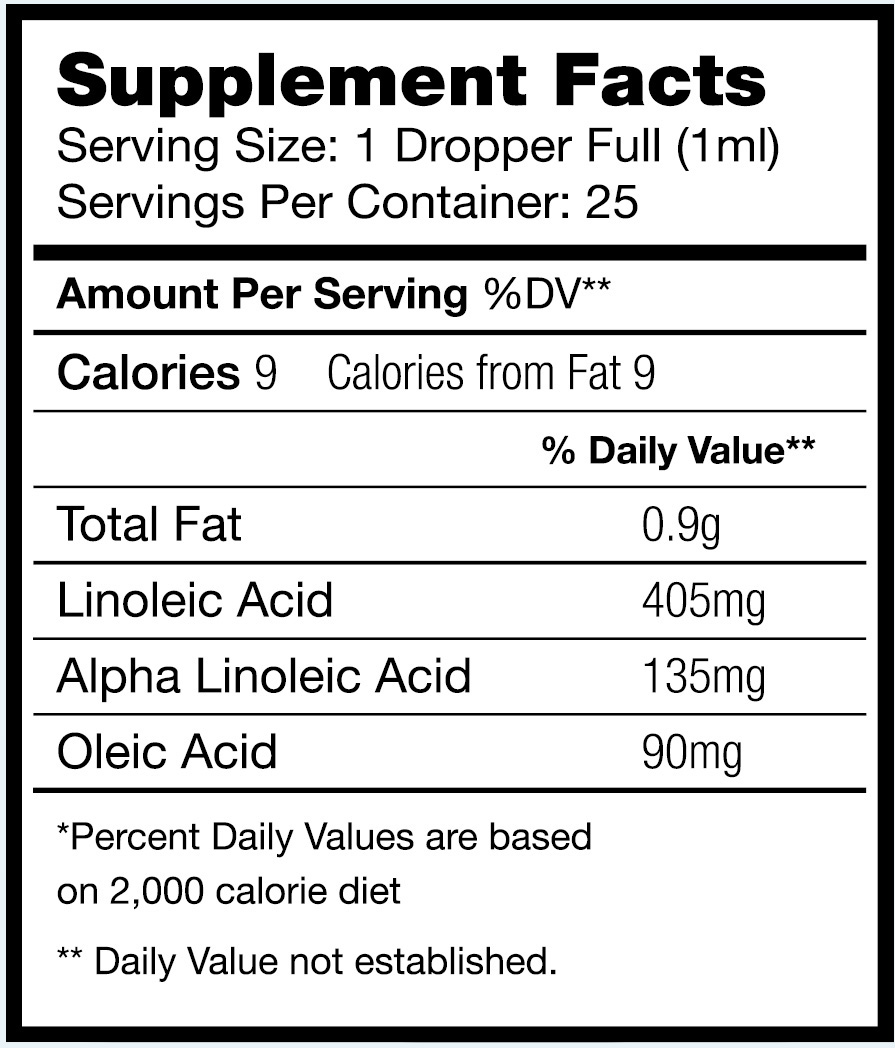READING THE LABEL
When considering a CBD product for purchase, read the label or product description carefully, and be sure you understand the information presented.
Amount of CBD
Labels should tell you the amount of CBD in the product. There are two spots on the package to look for the total amount of CBD. The first is the “Supplement Facts” panel. Here you’ll find the amount of CBD provided as milligrams per serving.
Otherwise, the concentration of CBD may be listed anywhere else on the package. In this case, the total amount of CBD in the product is just provided outright. When provided outright, you’ll find the total milligrams of CBD in the product, not the amount of CBD per serving. (Note that the amount of THC may not be listed, as it’s not the active ingredient in the product.)

This product has 25mg of CBD per .5mL serving, and there are 30 servings per container, so the total amount of CBD is 750mg in the 15mL container.
To compare the concentration of CBD in different CBD goods, look at products of equivalent volumes. The concentration in the most common form of CBD—the oil—can range from 250 milligrams per fluid ounce to about 1,000 milligrams per fluid ounce.
Now, here’s a really important point to take note of: some labels simply don’t state the amount of CBD anywhere on the label, which doesn’t really serve you, the consumer. You need to know exactly what you’re putting in your body and how much of it. Taking too little CBD gives you no medical benefit, and taking too much CBD can result in adverse side effects, even if they’re not serious.
A well-labeled CBD oil should include the exact amount of CBD, whether it’s the total amount of CBD outright or the amount of CBD per serving.
Avoid Products with Unclear Labeling

This label indicates the amount of “Phytocannabinoid Hemp Oil” per serving. The word phytocannabinoid encompasses over 100 different cannabinoids made by hemp. This might include CBD, but you don’t know for sure.

This label indicates the amount of “Hemp Extract” per serving. The word extract encompasses all the chemicals made by hemp in its concentrated form. You don’t know if there is CBD in the product, or how much.

This particular label gives you no information whatsoever. There may be CBD in this product. There may not be. The world may never know. Don’t bother considering a product that’s labeled like this.
Serving Size
Now, I want to turn your attention to the serving size, which is also part of the supplement facts panel. It’s important to understand that the amount listed as one serving is just an estimate. It may or may not be the right serving size for you. For some, that amount might be too much. For others, that amount might be too little. In my experience treating patients, I’ve found that the serving size, or dose, varies greatly from person to person. You can use the serving size listed on the label as a guide, but ultimately, it’s best to work with an experienced doctor to figure out the dose that’s right for you, especially if you’re using CBD to treat a specific medical problem.
Isolate vs. Full Spectrum
Some CBD products are marketed using the terms “CBD isolate” or “full-spectrum CBD.” I’ll give you a very clear idea of what they mean so that you can be a smart consumer.
The term full-spectrum means that the product contains CBD plus all the other cannabinoids found in the hemp plant. Of course, this includes the trace amounts of THC, up to 0.3 percent. The terms “full-spectrum” and “whole plant” are often used interchangeably.
An isolate, as the name implies, contains just CBD that’s been extracted from the hemp plant and is isolated from the other cannabinoids. The CBD is isolated using a process called chromatography. It’s a separation method used to isolate a single chemical from a mixture. CBD products made with isolate CBD are typically labeled as “pure CBD.”
Now, here’s the all-important question: Which is more effective, full-spectrum CBD or isolate CBD? Research done on mice at Israel’s Hebrew University showed that CBD in its full-spectrum form was far more effective than CBD as an isolate. One group of mice was administered CBD in its full-spectrum form, while another group of mice was given CBD as an isolate. The study found that far smaller doses of full-spectrum CBD were needed than isolate CBD to achieve the same pain-relieving effect. In other words, the mice got more bang for their buck with the full-spectrum CBD compared to the isolate CBD.
So, it’s quite possible that CBD combined with the other phytocannabinoids, in full-spectrum form, may be more effective than on its own as an isolate.
Extract Solvents
In Part 1, we looked at the various ways CBD can be extracted from the hemp plant. Some of these extraction solvents are more desirable than others. Avoid CBD extracted using a hydrocarbon, which has been associated with increased health risks, even in small amounts. CBD extracted using carbon dioxide and ethanol are better options. CBD extracted in an oil may be acceptable as well, depending on your needs.
A Word of Caution
Because CBD is not subject to federal regulation, there’s a chance that what you see on the label is not what you get. In 2015 and 2016, the FDA set out to test the CBD content of CBD oils from a variety of manufacturers. They found that in many cases, the product labels wildly misrepresented the actual CBD content of the product. Many of the tested CBD oils contained much less CBD than indicated on the label. In addition, some of the CBD oils contained more than 0.3 percent THC.
A 2017 study showed similar results. In this study, researchers tested 84 different CBD products from 31 different companies. According to their results:
- 42.85% of the products were underlabeled, meaning the CBD content in the product exceeded the labeled amount by more than 10 percent.
- 26.19% of the products were overlabeled, meaning the CBD content in the product was less than the labeled amount by more than 10 percent.
- Only 30.95% of the products were accurately labeled, meaning the CBD content of the product tested within 10 percent of labeled amount.
Interestingly, some types of products were more likely to be mislabeled than others. Vaporization liquid was the most frequently mislabeled, while oil was the product most frequently labeled accurately.
The risks of using a mislabeled product are relatively low, but may cause adverse effects. An overlabeled product (having less CBD than reported) won’t work to alleviate symptoms, leading to a waste of your time and money. An underlabeled product (having more CBD than reported on the label) is not a great concern because CBD doesn’t appear to have abuse liability or serious adverse consequences at high doses; however, it may cause side effects such as drowsiness. And, of course, a product with levels of THC higher 0.3 percent may cause an unwanted high.
How do you avoid purchasing a mislabeled product? The answer is to demand state-licensed, third-party lab tests that provide unbiased information about the content of the product.
